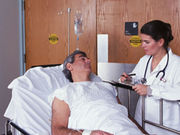Researchers find an association with elevated risk of Clostridium difficile infection
TUESDAY, Oct. 11, 2016 (HealthDay News) — When a hospital patient is taking antibiotics, the next patient to use the same bed may face an elevated risk of Clostridium difficile infection (CDI), according to a study published online Oct. 10 in JAMA Internal Medicine.
Daniel Freedberg, M.D., a gastroenterologist at the Columbia University Medical Center in New York City, and colleagues studied 100,615 patient pairs. All were in one of four New York-area hospitals from 2010 to 2015. New patients had to have spent 48 hours in a bed in which the last patient spent at least a day and had left the bed less than a week before the next occupant.
The suspected connection was borne out in 576 pairs. In those cases, the later patient developed CDI within two to 14 days after occupying the bed, the researchers found. Average time to infection was around six days. And these newly infected patients were more likely to have the usual CDI risk factors — older age, increased levels of creatinine, decreased levels of albumin, and past use of antibiotics. The risk of CDI was 0.72 percent when the prior occupant of the hospital bed received antibiotics, compared with 0.43 percent when the prior occupant of the bed did not receive antibiotics. Apart from antibiotics, no other factors related to the prior bed occupants were associated with increased risk for CDI in subsequent patients. That remained the case after excluding 1,497 patient pairs in which the prior patient recently had CDI.
“Antibiotics encourage the spread of C. difficile from patients who asymptomatically carry C. difficile to patients who are C. difficile-free, even if the C. difficile-free patients do not receive any antibiotics,” Freedberg told HealthDay.
Full Text
Copyright © 2016 HealthDay. All rights reserved.








